|
 Secure Site
Secure Site
|
 |
Archive for the 'mindfulness practice' Category
 Mountan Meditation Mountain Meditation
Create a comfortable, stable, supported seated posture. If sitting on the floor, support your knees with pillows or blocks. Sit upright and close your eyes. Let your breath flow naturally, without manipulating it. Rest your attention on the rising and falling of your belly or chest.
Imagine a majestically tall mountain. Contemplate how solid and stable the mountain is throughout the changing seasons. At times the mountain may be clouded over, its peak covered in fog. Sometimes the mountain is assaulted with thunder, lightning, and heavy rains. Sometimes it rises into a clear blue sky or a few white puffy clouds. At times it is covered in snow, at times with lush foliage, and at other times it is barren. Throughout, it remains stable and unaffected by the changing weather or seasons. Let this stable quality of “mountainness” nourish your concentration and your ability to sit through all the varying experiences that arise while practicing this meditation.
Now feel your posture to be like a mountain. Breathing in, see yourself as a mountain; breathing out, feel stable. Some thoughts and emotions are like storms, others like sunshine. Your mind can be clouded over or clear and bright, but through it all, you can still sit solid.
adapted from Yoga Journal, by Frank Jude Boccio
 Meditation Timer with Singing Bowl Now & Zen
1638 Pearl Street
Boulder, CO 80302
(800) 779-6383
Posted in Bamboo Chime Clocks, Meditation Timers, Meditation Tools, mindfulness practice, Now & Zen Alarm Clocks, Well-being
 Zen Timepiece with brass bowl
Discover the healing power of sound with singing bowls, tuning forks, and other musical instruments.
Music can move us to tears, help us feel calm or comforted, or inspire us to action. The rhythmic sounds of nature (think of waves breaking on a beach) can bring us into balance. Now researchers are learning more about how music and sound directly affect the healing process.
EVIDENCE. A 2008 study at the University of Maryland School of Medicine revealed that listening to music you consider joyful for 30 minutes helps release endorphins to relieve pain and reduce stress, which can otherwise overload your immune system and lead to a host of health conditions. Another study completed last year at Seattle University in Washington showed that listening to Mozart for 12 minutes three times a week can lower systolic blood pressure by seven points.
YOUR BODY TUNES IN. Researchers say that when you listen to music and sounds, your heartbeat, breath, and brain waves begin to slow down or speed up in response to what you’re hearing. Your body syncs up with the sound, and the result can be an enhanced relaxation response—stress lifts, your heartbeat slows, muscles relax, and your body releases feel-good endorphins—or improved energy levels, depending on the rhythm.
GET STARTED. Try these ways to benefit from sound therapy:
EASE STRESS:
Use tuning forks and singing bowls
“Sonic tools” like tuning forks and singing bowls can soothe an overexcited nervous system, says Jonathan Goldman, author of The Seven Secrets of Sound Healing (Hay House, 2008). Singing bowls create a calming noise when you run a mallet around the rim, and tuning forks hum when tapped.
Try it: Use these tools as frequently as needed, says Goldman. For tuning forks, go to Healing Sounds or Biosonics. For crystal singing bowls, visit Crystal Tones. For Tibetan singing bowls, try Now & Zen, Inc., Headquarter Store, 1638 Pearl Street, Boulder, CO 80302.
RELIEVE INSOMNIA:
Listen to a healing CD
“Music is to the nervous system what nutrients are to the body,” says Joshua Leeds, author of The Power of Sound (Healing Arts Press, 2001). He designs audio CDs with music, special effects, and sounds from the natural world to enhance various activities, such as falling asleep.
Try it: See Sound Remedies or Steven Halpern Inner Peace Music.
SHARPEN YOUR MIND:
Learn an instrument
Studies show that daily practice of a musical instrument can keep the brain young and pliable. It can also help relieve tension as your body actually resonates with the soft energies of the instrument.
Try it: Find a local teacher and ask about beginner lessons. Practicing for five minutes can clear tension and a foggy mind. Use your Zen Timepiece in the morning to wake up to a singing bowl for a gentle and progressive awakening.
Our Zen Timepiece’s acoustic 6-inch brass bowl-gong clock is the world’s ultimate alarm clock, practice timer, and “mindfulness bell.”
 Natural Sound Alarm Clocks & Sound Therapy It fills your environment with beautifully complex tones whenever it strikes. In the morning, its exquisite sounds summon your consciousness into awakening with a series of subtle gongs that provide an elegant beginning to your day. Once you experience the Zen Timepiece’s progressive awakening, you’ll never want to wake up any other way. It also serves as the perfect meditation timer.
adapted from Natural Health Magazine July 2010, by Elizabeth Casey
 Singing Bowl Clocks by Now & Zen called The Zen Timepiece
Posted in Bamboo Chime Clocks, Chime Alarm Clocks, Goodness, Meditation Timers, Meditation Tools, mindfulness practice, Natural Awakening, Progressive Awakening, Well-being, Zen Timepiece by Now & Zen, Zen Timers
 meditation trains your brain Using a magnetic resonance imaging (MRI) machine, Eileen Luders, a re-searcher in the Department of Neurology at the University of California Los Angeles School of Medicine, looks for evidence that meditation changes the physical structure of the brain. Until recently, this idea would have seemed absurd. “Scientists used to believe that the brain reaches its peak in adulthood and doesn’t change—until it starts to decrease in late adulthood,” Luders says. “Today we know that everything we do, and every experience we have, actually changes the brain.” Indeed, Luders finds several differences between the brains of meditators and nonmeditators. In a study published in the journal NeuroImage in 2009, Luders and her colleagues compared the brains of 22 meditators and 22 age-matched nonmeditators and found that the meditators (who practiced a wide range of traditions and had between 5 and 46 years of meditation experience) had more gray matter in re-gions of the brain that are important for attention, emotion regulation, and mental flexibility. Increased gray matter typically makes an area of the brain more efficient or powerful at processing information. Luders believes that the increased gray matter in the meditators’ brains should make them better at controlling their attention, managing their emotions, and making mindful choices.
Why are there differences between the brains of meditators and nonmeditators? It’s a simple matter of training. Neuroscientists now know that the brain you have today is, in part, a reflection of the demands you have placed on it. People learning to juggle, for example, develop more connections in areas of the brain that anticipate moving objects. Medical students undergoing periods of intense learning show similar changes in the hippocampus, an area of the brain important for memory. And mathematicians have more gray matter in regions important for arithmetic and spatial reasoning.
More and more neuroscientists, like Luders, have started to think that learning to meditate is no different from learning mental skills such as music or math. Like anything else that requires practice, meditation is a training program for the brain. “Regular use may strengthen the connections between neurons and can also make new connections,” Luders explains. “These tiny changes, in thousands of connections, can lead to visible changes in the structure of the brain.” Those structural changes, in turn, create a brain that is better at doing whatever you’ve asked it to do. Musicians’ brains could get better at analyzing and creating music. Mathematicians’ brains may get better at solving problems. What do meditators’ brains get better at doing? This is where it gets interesting: It depends on what kind of meditation they do.
Over the past decade, researchers have found that if you practice focusing attention on your breath or a mantra, the brain will restructure itself to make concentration easier. If you practice calm acceptance during meditation, you will develop a brain that is more resilient to stress. And if you meditate while cultivating feelings of love and compassion, your brain will develop in such a way that you spontaneously feel more connected to others.
The Zen Meditation Timer and Clock’s long-resonating Tibetan bell-like chime makes waking and meditating a beautiful experience – its progressive chimes begin your day with grace.
adapted from Yoga Journal, By Kelly McGonigal
 Digital Zen Alarm Clock, a meditation timer and progressive alarm clock Now & Zen’s Meditation Timer Shop
1638 Pearl Street
Boulder, CO 80302
(800) 779-6383
Posted in Bamboo Chime Clocks, intention, Meditation Timers, Meditation Tools, mindfulness practice, Now & Zen Alarm Clocks, Zen Timers
 Bach's wake up call The theme of spiritual life as a kind of awakening is a metaphor found in every culture and tradition. You might enjoy listening to music by the great German composer Johann Sebastian Bach, who chose the theme of awakening for a cantata he composed in 1731. Inspired by the Gospel of Matthew 25:1–13, it opens with the words, “Wachet auf, ruft uns die Stimme” (Sleepers awake! The Voice calls to us).
Rolf Sovik, PsyD, is the author of Moving Inward: The Journey to Meditation. He is the president of theHimalayan Institute, and serves as the director of the Institute’s branch center in Buffalo, New York.
 Musical Chime Alarm Clock with Real Acoustic Sounds Now & Zen
1638 Pearl St.
Boulder, CO 80302
(800) 779-6383
Posted in mindfulness practice, Natural Awakening, nature, Now & Zen Alarm Clocks
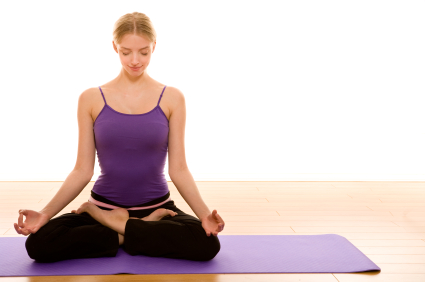 stillness practice using breath Meditation is easy in theory but fiendishly difficult in practice—unless you can give your mind a vehicle for moving inward.
By Rolf Sovik
Once your meditation posture feels relaxed and comfortable, try these five simple steps:
1. Become aware of your breathing. Feel the sensations of cleansing and nourishing that accompany each breath.
2. Relax your abdomen and rib cage so that your breathing flows effortlessly.
3. Weave each breath smoothly into the next, letting the breath flow without jerks or pauses.
4. Continue observing your breathing until you feel your nervous system relax. Maintain the smooth flow of breathing even when distractions disturb your mind.
5. Try working with the mantra soham (pronounced “so-hum”). Link the sound so… to your inhalation and the sound hum… to your exhalation. Let the breath and mantra flow together in perfect harmony, until your mind rests in the sound of the mantra.
Now your meditation will unfold in the mantra sound (so…hum…). Bringing so…hum… to awareness provides the mind with a quiet resting place during meditation. Maintaining just a sliver of awareness on the breath, along with the mantra, will help your meditation unfold.
 Meditation Timers and Alarm Clocks with Acoustic Sounds, Boulder, CO Now & Zen
1638 Pearl St.
Boulder, CO 80302
(800) 779-6383
Posted in Chime Alarm Clocks, Meditation Timers, Meditation Tools, mindfulness practice, Now & Zen Alarm Clocks
 zen stones It’s hard to believe in the sages’ promise of higher consciousness—until that breakthrough moment happens to you. Here, a report from those who’ve been there.
By Deborah Willoughby
Edgar Mitchell was on his way home. Two days before he had been on the moon collecting rock samples, and now he was speeding through space accompanied by two other astronauts. Gazing at Earth and the stars through the tiny window of Apollo 14, he was engulfed by a new and startling sensation: an all-encompassing aura of universal connectedness. All sense of boundaries dissolved, and he saw that he, his companions, and everyone and everything on the shining planet in the window were held in a luminous web of consciousness. What is more, he knew with absolute certainty that, as he put it later, “the glittering cosmos itself was in some way conscious.”
Mitchell was experiencing a spontaneous glimpse of what the sages of the yoga tradition call higher consciousness—a direct, intuitive experience of the infinite field of awareness that underlies and pervades the entire universe. When this experience is fully expanded, different traditions give it different names—samadhi, nirvana, enlightenment, turiya, shunyata, Brahman, Christ Consciousness, Absolute Truth, Atman, God, the Self, Supreme Consciousness—but whatever they call it, spiritual masters tell us that this experience of an all-pervasive consciousness reveals the truth about ourselves and the world we inhabit: it is all One. There is no division, no multiplicity, no separation. Everything—the astonishing variety of living beings; nature’s myriad shapes, textures, and forms; the sun, the stars, the clouds, and the wind in the trees—all of it is a manifestation of an indivisible field of Consciousness. The goal of human life, the sages tell us, is to meet that Consciousness within ourselves and to know ourselves as That.
The sages also tell us all of our problems, indeed all of the world’s problems, can be traced to a single source: we misunderstand the nature of reality. Hypnotized by outward appearances, we misread the world around us. We see multiplicity instead of unity, separation instead of wholeness. Because we don’t understand that all beings share one life force, one consciousness, we blunder about, damaging ourselves by damaging others. It all boils down to an epic misunderstanding—and leaves us looking for fulfillment in all the wrong places.
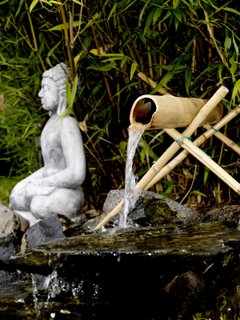 stillness practice “We are all looking for the peace and freedom and security of perfect union with the Atman,” Swami Prabhavananda and Christopher Isherwood write in How to Know God, their classic commentary on theYoga Sutra. “We all long desperately to be happy. But ignorance misdirects us. It assures us that the Atman cannot really be within us, that we are nothing but individuals, separate egos…. We seek security in the accumulation of possessions, or by the destruction of our imagined enemies. We seek happiness through sense gratification, through every kind of vanity and self-delusion. We seek peace through the intoxication of various drugs. And in all these activities we display an energy of heroic proportions…. It is tragically misdirected energy. With less effort, we might easily have found union with the Atman, had we not been misled by our ignorance.”
The good news is that this veil of ignorance is readily lifted. Experiencing Consciousness is simplicity itself, the sages tell us—after all, it is our own true nature. As the 14th-century master, Vidyaranya Yati put it, “You are whatever you know yourself to be. This is a simple law. Brahmavit Brahmaiva bhavati. The knower of Brahman becomes Brahman. The moment you know that you are inseparable from Universal Consciousness, you become that Universal Consciousness.” Five centuries later, Swami Vivekananda put it another way: “The moment I have realized God sitting in the temple of every human body, the moment I stand in reverence before every human being and see God in him—that moment I am free from bondage, everything that binds vanishes, and I am free.” My own teacher, Swami Rama, had another way of expressing it: “It’s as simple as flipping a light switch. Suppose this room is kept dark for one hundred years. How long will it take to light this room? One second.”
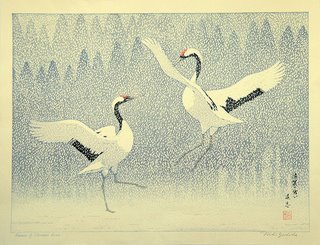 sousaku hanga woodblock print by Yoshida Toshi (ca 1970's Swamiji’s spiritual heir, Pandit Rajmani Tigunait, takes the same view, as I discovered one winter morning while complaining to him about feeling spiritually stuck. Panditji leaned forward, took my face in his hands, and turned my head a few degrees. “It’s right there,” he said forcefully. “There! Adjust your gaze a fraction, you’ll see it. Everything is Consciousness. Everything!”
Most of us don’t see it—at least not at first and not easily. It’s like an Escher print. First you see one thing—black ducks flying across a white sky—and then your perspective shifts a hair and you are looking at a picture of white fish swimming through black water. Once you’ve seen the fish, you see them every time you glance at the print. Spiritual teachers say that the unity underlying the apparent diversity is like that—palpable, obvious, and undeniable. The trick is to learn to refocus our gaze.
To do that, it helps to know what we’re attempting to see. The image on the opposite page seems unremarkable, but if you know it’s a stereogram, you will study it more closely. Look at it long enough and in the right way, and the bees recede into the distance and the hummingbirds float across the page in three dimensional rows. That’s what meditation is, looking within from the right angle often enough and long enough for the illusion of separateness to drop away and Reality to snap into focus.
Swami Rama was fond of saying, “It is easy to meet that Infinity within you—to attain that awareness, you just have to be silent.” It’s easy. Sit down, close your eyes, draw your attention inward, quiet your mind, and you are “There”—at least in theory. For most of us, the experience of meditation is quite different. We sit down, close our eyes, draw our attention inward, and come face-to-face with a noisy, scattered, unruly mind. We mean to focus on the mantra but find ourselves composing the grocery list instead; the mind jumps to the day ahead or the upcoming weekend, the vacation we’d like to take or the one we just had; it busies itself sorting through the latest dustup at the office, skitters through the mess in Iraq, then slides off into what we’re getting the kids for Christmas. Silence eludes us—and so does an awareness of Infinity.
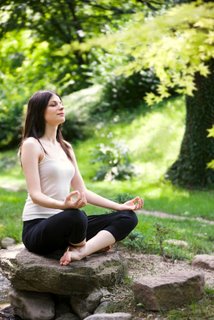 stillness It’s the classic chicken-and-egg dilemma. The experience of Oneness is the fruit of a disciplined meditation practice. But a disciplined meditation practice unfolds from a taste of that fruit. Once it’s had a taste of Unitary Consciousness, the mind is drawn to it like a bee to a blossom and is no longer so easily distracted when we sit for meditation. But without that initial taste, we’re at a bit of a loss. We believe—or would like to believe—what the scriptures, the sages, and our teachers tell us: that we are inextricably entwined in a nourishing web of Consciousness. But our day-to-day experience is quite different—we’ve become accustomed to a vision of duality, trained to see ourselves as separate from each other and from the natural world, and so that’s what we see. We’re seeking a deeper, richer vision of ourselves and our world but we don’t quite know how to bring it into focus.
It came into focus for Edgar Mitchell when he was 240,000 miles out from Earth, seeing his home planet cradled in a nest of stars. His work was essentially finished, the moonwalk had been a success, and he had time to reflect on the mission, time to “absorb the magnificence and beauty of the whole process.” As he explained it in an interview with The Monthly Aspectarian, as a result of “seeing Earth as it is in the heavens, the precise experience for me was to recognize that the molecules of my body and the molecules of the spacecraft—I had studied stellar formation and knew how the furnaces of the stars and galaxies created our chemical elements—I suddenly realized that those were my molecules being manufactured and prototyped in those stars. Instead of being an intellectual experience, it became a very deep, personal, emotional one, a knowing. It was such a profound experience that I went into a different realm of seeing things.”
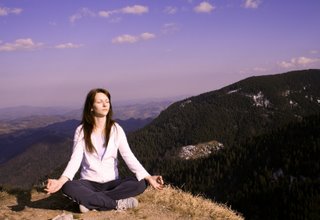 Meditation on the mountain I had a similar experience during a pilgrimage to Kedarnath, a shrine high in the Himalayas. Much less arduous than a journey to the moon, pilgrimage is a time-honored way of cultivating an expanded vision. Step away from the demands and distractions of daily life, leave the familiar behind, and go—deliberately and with determination—to a place known for its spiritual energy. Pandit Rajmani explains it this way: “If you are seeking a certain kind of knowledge and experience, go to a place where it is readily available. If you are seeking knowledge and experience in technology, go to MIT. If you are seeking an experience of the inner dimension of your life, go to a place charged with spiritual energy. When you go to such places with the intention of connecting yourself to the flow of all-pervading Consciousness, your individual consciousness is expanded and transformed by the collective consciousness which permeates that place.”
Mecca, Jerusalem, Assisi, Banaras, Allahabad, Mount Kailash, Mount Fuji, and Mount Kilimanjaro are among the places Consciousness has shaped in Her own image. Here at these and other shrines, the perceived barrier between the physical realm and the subtle realm thins to the point of transparency, and the all-embracing matrix of Consciousness shines through.
I caught a glimpse of it last summer in the Himalayas. From the moment I began the nine-mile climb from the village of Gaurikund to Kedarnath, I was flooded with joy. Everything was perfect—sunlight on thickly wooded hillsides, snowcapped peaks framed by impossibly steep gorges, waterfalls spilling down at every turn, a chilly afternoon rain, the blister on my right heel, a trail that got rougher and steeper as the day wore on, the clammy guesthouse, even the cold-water-only shower. During the two days we stayed on the Kedarnath plateau and through the long walk back to Gaurikund, perfection reigned.
Nothing I did, nothing anyone around me did, could dislodge the all-encompassing beatitude. On the trek back, I deliberately brought things to mind that had been troubling me before I set foot on the trail—my mother’s slide into dementia, a financial snafu, a friend’s duplicity—but they had lost their sting. Everything I knew, remembered, or could imagine was supported and nourished by a munificent web of Consciousness.
For three days, I saw it and felt it. The feeling has faded, but the memory remains. And it is that memory that pulls me into meditation practice, erasing much of the tendency to distraction. My mind settles and moves toward silence more readily now. It hasn’t become as easy as flipping a switch—not by a long shot—but having walked in the light, however briefly, I have come to understand why Swami Vivekananda said: “We put our hands over our eyes and weep that it is dark.”
Deborah Willoughby is the founding editor of Yoga International.
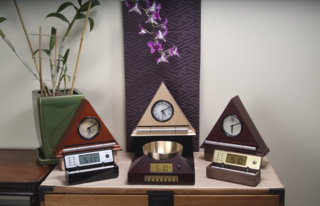 Yoga and Mediation Timers Now & Zen
1638 Pearl St.
Boulder, CO 80302
(800) 779-6383
Posted in Meditation Timers, Meditation Tools, mindfulness practice, Natural Awakening, nature
 Toyohara, Kunichika, 1835-1900 7 Sources of Prana
By Sherri Silverman
1. An open window in the northwest, the quadrant where the air element is predominant
2. A vamsa danda, or spine of light, running unobstructed from the front door straight through the house to a back window or door
3. An open Brahmasthan (the center of the building) to allow the structure to generate prana from the middle of the house
4. Live plants and flowers in the house; outdoor gardens
5. Meditation and healing breath techniques
6. Fresh, organic foods in the kitchen (ideally, harvested from your garden or local farmers’ market)
7. Water elements such as fountains and aquariums, which replicate streams, waterfalls, lakes, oceans, etc.
 Natural Chime Alarm Clocks with Real Acoustic Sounds Now & Zen
1638 Pearl St.
Boulder, CO 80302
(800) 779-6383
Posted in mindfulness practice, nature
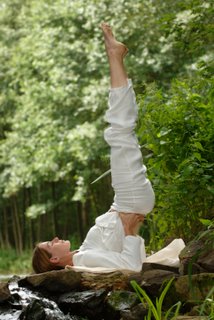 wellness practice of the day Before the hustle-bustle of the holidays throws your routine off-kilter, take some time to reconnect with the earth, viewed in most mind-body traditions as the source of power and stability. “We’re often mentally hovering a few feet above the ground,” says Kate Hanley, author of “The Anywhere, Anytime Chill Guide.” “It’s important to get back in touch with the ground beneath you.” So make a five-minute savasana your new daily habit: Set your Zen Wellness Timer for 5 minutes, lie on your back with your eyes closed, listening to your breath and feeling the earth support you.
adapted from Wholeliving.com, October 2010
Use our unique “Zen Clock” which functions as a Yoga & Meditation Timer. It features a long-resonating acoustic chime that brings your meditation or yoga session to a gradual close, preserving the environment of stillness while also acting as an effective time signal. Our Yoga Timer & Clock can be programmed to chime at the end of the meditation or yoga session or periodically throughout the session as a kind of sonic yantra. The beauty and functionality of the Zen Clock/Timer makes it a meditation tool that can actually help you “make time” for meditation in your life. Bring yourself back to balance.
 Wellness Timer, The Digital Zen Alarm Clock in Solid Walnut
Now & Zen – The Zen Alarm Clock Store
1638 Pearl Street
Boulder, CO 80302
(800) 779-6383
Posted in intention, mindfulness practice, Well-being, Yoga Timer, Yoga Timers by Now & Zen, Zen Timepiece by Now & Zen, Zen Timers
 What benefits can I get from meditation? Benefits may seem slow to come and are subtle at first, but are long lasting and very effective. Just like exercise, you’re not going to see the changes in your body right away, but if you keep with it, you know you will reap the benefits. It’s the same with meditation.
There are many benefits to practicing meditation, many of which have been scientifically documented and studied.
Natural Solutions Magazine, by Jill Englund, April 2011
 Meditation Timer and Clocks Now & Zen
1638 Pearl Street
Boulder, CO 80302
(800) 779-6383
Posted in Meditation Timers, Meditation Tools, mindfulness practice, Well-being
« Previous Page — « Previous Entries
Next Entries » — Next Page »
|
|
|
|